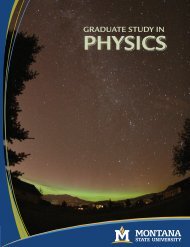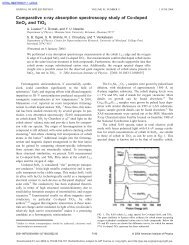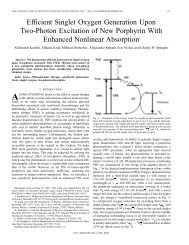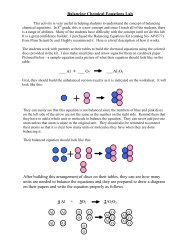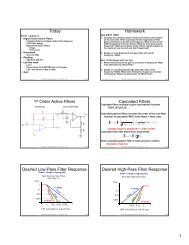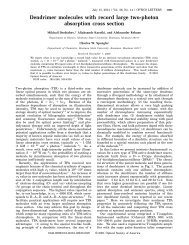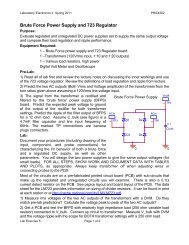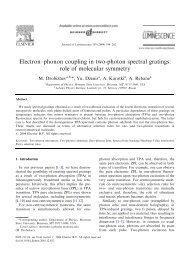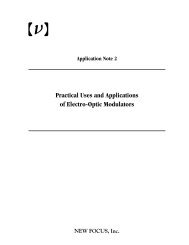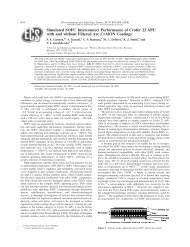Defects in inorganic photorefractive materials and their investigations
Defects in inorganic photorefractive materials and their investigations
Defects in inorganic photorefractive materials and their investigations
You also want an ePaper? Increase the reach of your titles
YUMPU automatically turns print PDFs into web optimized ePapers that Google loves.
8 B. Briat et al.<br />
low temperatures <strong>and</strong> high magnetic fields <strong>in</strong>crease the sensitivity. Also the<br />
heat<strong>in</strong>g of crystal specimens by the resonant absorption of microwaves can<br />
be used, lead<strong>in</strong>g to thermally detected EPR [16]. Double resonance methods,<br />
to be <strong>in</strong>troduced <strong>in</strong> the follow<strong>in</strong>g, constitute further ways to detect the EPR<br />
transitions.<br />
Important <strong>in</strong>formation on the defect wavefunction is furnished by hyperf<strong>in</strong>e<br />
<strong>in</strong>teraction. If a hyperf<strong>in</strong>e splitt<strong>in</strong>g is resolved, the result<strong>in</strong>g (2I i +1) l<strong>in</strong>es<br />
allow the sp<strong>in</strong> I i of the correspond<strong>in</strong>g nucleus to be identified. This gives a<br />
strong h<strong>in</strong>t of the chemical identity of this nucleus. The tensor A i (eq. 1) partly<br />
depends on the density of the wavefunction at the local probe represented by<br />
nucleus i. If hyperf<strong>in</strong>e <strong>in</strong>teraction orig<strong>in</strong>ates from parts of the wavefunction<br />
with low probability density, the correspond<strong>in</strong>g small splitt<strong>in</strong>gs are usually not<br />
resolved. Then the electron nuclear double resonance (ENDOR) [13] technique<br />
(Fig. 4) may help: Here, us<strong>in</strong>g a special experimental scheme, the highly resolved<br />
nuclear magnetic resonances, ly<strong>in</strong>g at radio frequencies, are detected by<br />
changes of the <strong>in</strong>tensities of the correspond<strong>in</strong>g EPR signals. If applicable, this<br />
technique leads to the most detailed <strong>in</strong>formation about a defect wavefunction,<br />
e.g. its spatial distribution <strong>and</strong> the nuclei it encompasses.<br />
We consider now magnetic circular dichroism (MCD), i.e. the differential<br />
absorbance, ∆α = α + − α − , presented by a cubic or uniaxial sample for<br />
left (σ + ) <strong>and</strong> right (σ−) polarized light propagat<strong>in</strong>g along the direction of<br />
an applied magnetic field. In general [17, 18, 19] the MCD signal associated<br />
with an isolated electronic transition conta<strong>in</strong>s two ma<strong>in</strong> contributions. The<br />
diamagnetic term (S-shaped <strong>and</strong> temperature-<strong>in</strong>dependent) results from the<br />
difference <strong>in</strong> energy of the circularly polarized components. Although always<br />
present down to relatively low temperatures <strong>in</strong> the case of very sharp l<strong>in</strong>es (e.g.<br />
lanthanide ions [18]), it can be safely ignored <strong>in</strong> the case of the broad b<strong>and</strong>s at<br />
low temperature. The paramagnetic term (absorption-like shape, temperature<br />
dependent) monitors the magnetization <strong>in</strong> the groundstate. In the case of sp<strong>in</strong><br />
S = 1 2<br />
(Fig. 4) it is proportional to the difference <strong>in</strong> relative populations at<br />
equilibrium (eq. 2) between its two Zeeman sublevels. Experiments at very<br />
low temperatures (pumped helium) thus furnish the largest MCD signals The<br />
technique is very sensitive s<strong>in</strong>ce the smallest detectable absorbance is about<br />
10 −5 , i.e. roughly two orders of magnitude smaller than with a classical spectrometer.<br />
In the case of the sillenites, Fe <strong>and</strong> Cr impurities could be monitored<br />
down to the ppm level.<br />
The term ODMR has often been used <strong>in</strong> connection with the detection of<br />
EPR by various features of photolum<strong>in</strong>escence transitions [13]. S<strong>in</strong>ce a study<br />
of the <strong>photorefractive</strong> effect requires the assignment of the optical absorption<br />
b<strong>and</strong>s, we concentrate rather on the optical detection of magnetic resonance<br />
(ODMR) via the magnetic circular dichroism (MCD). The signal ∆α is measured<br />
as a function of B/T <strong>and</strong> a dip is observed (|∆n| (eq. 2) is reduced) <strong>in</strong><br />
the saturation curve, whenever the resonance conditions are fulfilled.<br />
The great advantage of the MCD-ODMR method is its ability to connect<br />
optical absorption features to <strong>their</strong> microscopic orig<strong>in</strong>s <strong>in</strong> the logically



